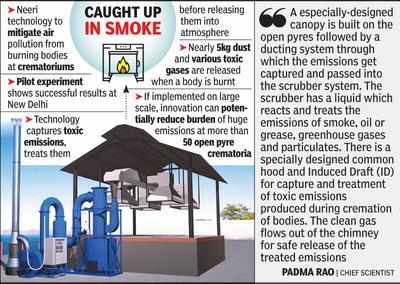- News
- City News
- nagpur News
- Neeri develops technology to control air pollution emanating from cremations
Neeri develops technology to control air pollution emanating from cremations

Nagpur: When a human body is burnt, nearly 5kg of dust, along with toxic gases, is released into the atmosphere. To address this major source of air pollution, the National Environmental Engineering Research Institute (Neeri) has developed a technology to mitigate dangerous emissions from open pyre green crematoria.
At a time when crematoriums are flooded with bodies due to the on-going Covid-19 pandemic, the technology can prove useful for addressing concerns related to public health. In a pilot experiment, the technology has been successfully implemented at four pyres at Nigam Bodh ghat in New Delhi, where significant emission reduction has been observed. “Massive piles of firewood are burnt in the open during the cremation process. Apart from particulate matter 10 and 2.5, toxic gases like ozone, Polycyclic Aromatic Hydrocarbons (PAHs), oxides of nitrogen, carbon monoxide and other are also released, which are extremely harmful for the human health,” said chief scientist Padma Rao.
Explaining the technology, the scientist said the system comprises of fume collection and handling facility, scrubbing and processing, and utilities and waste handling systems. “A especially-designed canopy is built on the open pyres followed by a ducting system through which the emissions get captured and passed into the scrubber system. The scrubber has a liquid which reacts and treats the emissions of smoke, oil or grease, greenhouse gases and particulates. There is a specially designed common hood and Induced Draft (ID) for capture and treatment of toxic emissions produced during cremation of bodies. The clean gas flows out of the chimney for safe release of the treated emissions,” added Rao.
The technology also has an effluent treatment plant through which waste liquid can be treated and recycled.
Highlighting benefits of the innovation, Rao said, “If implemented on a large scale, it can potentially reduce the burden of huge emissions at more than 50 open pyre crematoria in New Delhi and other cities. This will lead to massive reduction in exposure of toxic pollutants to humans and improving the air quality. The technology also aids in achieving the country’s commitment under Swachh Bharat Mission and sustainable development goals.”
Neeri is in talks with some municipal corporations which are willing to adopt this technology. The institute is working towards technology transfer of the innovation.
The technology was recently appreciated by Union science and technology minster Dr Harsh Vardhan, who inaugurated the pilot project. The minister stated that the innovation can also be applied to mitigate dispersed air pollution emitted from unorganized and informal industrial sectors.
At a time when crematoriums are flooded with bodies due to the on-going Covid-19 pandemic, the technology can prove useful for addressing concerns related to public health. In a pilot experiment, the technology has been successfully implemented at four pyres at Nigam Bodh ghat in New Delhi, where significant emission reduction has been observed. “Massive piles of firewood are burnt in the open during the cremation process. Apart from particulate matter 10 and 2.5, toxic gases like ozone, Polycyclic Aromatic Hydrocarbons (PAHs), oxides of nitrogen, carbon monoxide and other are also released, which are extremely harmful for the human health,” said chief scientist Padma Rao.
Explaining the technology, the scientist said the system comprises of fume collection and handling facility, scrubbing and processing, and utilities and waste handling systems. “A especially-designed canopy is built on the open pyres followed by a ducting system through which the emissions get captured and passed into the scrubber system. The scrubber has a liquid which reacts and treats the emissions of smoke, oil or grease, greenhouse gases and particulates. There is a specially designed common hood and Induced Draft (ID) for capture and treatment of toxic emissions produced during cremation of bodies. The clean gas flows out of the chimney for safe release of the treated emissions,” added Rao.
The technology also has an effluent treatment plant through which waste liquid can be treated and recycled.
Highlighting benefits of the innovation, Rao said, “If implemented on a large scale, it can potentially reduce the burden of huge emissions at more than 50 open pyre crematoria in New Delhi and other cities. This will lead to massive reduction in exposure of toxic pollutants to humans and improving the air quality. The technology also aids in achieving the country’s commitment under Swachh Bharat Mission and sustainable development goals.”
Neeri is in talks with some municipal corporations which are willing to adopt this technology. The institute is working towards technology transfer of the innovation.
The technology was recently appreciated by Union science and technology minster Dr Harsh Vardhan, who inaugurated the pilot project. The minister stated that the innovation can also be applied to mitigate dispersed air pollution emitted from unorganized and informal industrial sectors.
FacebookTwitterLinkedinEMail
end of article
Top Stories Right Now
- indiaGovt hopeful of vaccinating all adults by Dec, vaccine crunch may ease by July
- india90 lakh doses/day will be needed in August-December to achieve target
- indiaLive: India's Covid cases dip to 3.2 lakh, toll remains high at 3,883
- india‘Tauktae’ set to intensify into ‘very severe cyclone’, may hit Gujarat
- indiaGovernment may buy 50 million Pfizer Covid vaccine doses by Q3
Quick Links
Delhi Air PollutionDelhi TemperatureChennai WeatherBangalore TemperatureCovid vaccination centres in DelhiCoronavirus in DelhiRTPCR test in GurgaonHyderabad RainPollution level in BangaloreDelhi SmogDelhi TemperatureNoida AQIGurgaon AQI todayFire in MumbaiMumbai RainsCovid 19 RT PCR Test in NoidaDelhi AQI todaySrinagar encounter
